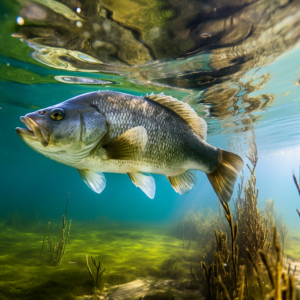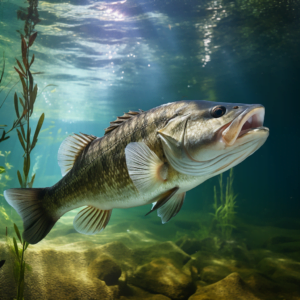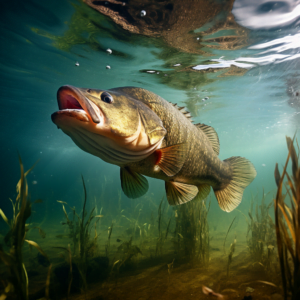Have you ever wondered whether black bass is a bony fish? In the realm of fish, this is a topic that frequently comes up. It is important to understand the anatomy of black bass to determine whether it falls under the category of bony fish or not. In this article, we will delve deeper into the characteristics of black bass and explore whether it indeed belongs to the bony fish family. So, if you’re curious about the true nature of black bass, keep reading to find out more!
Black bass, scientifically known as Micropterus, comprises several species such as largemouth bass, smallmouth bass, and spotted bass. These fish are widely popular among anglers for their sporty behavior and delicious meat. But are they bony or do they possess some other unique quality? To answer this question, we need to understand the skeletal structure of black bass. Unlike cartilaginous fish, such as sharks, black bass falls into the category of bony fish, belonging to the class Osteichthyes. They have a well-developed skeleton composed of bones, just like humans do.
One of the main characteristics that differentiate bony fish from others is the presence of an operculum, commonly known as gill covers. Black bass possesses an operculum that helps in the process of respiration by protecting the delicate gills. This is a key feature of bony fish, as it aids in their survival by allowing them to efficiently extract oxygen from water. Furthermore, black bass also have a swim bladder, which is an internal gas-filled organ that aids in buoyancy control. These distinct features clearly indicate that black bass indeed belongs to the bony fish family.
In conclusion, black bass falls into the category of bony fish, as it possesses a well-developed skeleton composed of bones. Its operculum and swim bladder are characteristic features of bony fish, aiding in respiration and buoyancy control, respectively. So, the next time you come across a black bass, you can confidently label it as a bony fish. If you’re interested in discovering more about the fascinating world of fish anatomy, read on for more intriguing insights!
Introduction to Black Bass
Black bass is a species of fish that has gained popularity among anglers and fish enthusiasts. You might have come across black bass while fishing or searching for information about different types of fish. In this article, we will explore the characteristics of black bass, its habitat, diet, reproductive behavior, predators, and threats. We will also dive into its significance as a sport fish and its culinary uses. But first, let’s answer the question, is black bass a bony fish?
Different types of black bass
Before we delve into the specifics, it is important to note that there are several species of black bass. The most well-known types include largemouth bass (Micropterus salmoides), smallmouth bass (Micropterus dolomieu), and spotted bass (Micropterus punctulatus). Despite their differences, they all fall under the category of bony fish.
Physical characteristics of black bass
Black bass are among the most visually striking freshwater fish. They have a streamlined body shape, which allows them to move swiftly through the water. Their most notable feature is their mouth, which extends beyond their eyes, giving them a voracious appearance. Black bass have a dark olive-green to black coloration on their backs, which fades into lighter shades on their sides and belly. Additionally, they possess vertical bands or spots on their bodies, adding to their unique aesthetic.
Habitat and distribution of black bass
Black bass are native to North America and are predominantly found in freshwater habitats such as lakes, rivers, and ponds. They thrive in clear waters with abundant vegetation and submerged structures, such as fallen trees and rocks. Largemouth bass are more commonly found in still waters, while smallmouth bass are often seen in faster-moving rivers and streams. Spotted bass, on the other hand, are typically found in reservoirs and other man-made bodies of water.
Bony Fish vs. Cartilaginous Fish
To understand whether black bass is a bony fish, it is essential to grasp the concept of bony fish and differentiate it from cartilaginous fish.
Definition and characteristics of bony fish
Bony fish, as the name suggests, have a skeleton composed mainly of bone. They are the most diverse and abundant group of vertebrates, with over 30,000 known species. One of their distinguishing features is the presence of a swim bladder, an organ that enables them to control their buoyancy. Bony fish also have gills that extract oxygen from the water, allowing them to respire underwater.
Definition and characteristics of cartilaginous fish
Cartilaginous fish, on the other hand, have a skeleton made of cartilage, a flexible and lightweight connective tissue. Examples of cartilaginous fish include sharks, skates, and rays. Unlike bony fish, they lack a swim bladder and rely on their liver and oily tissues for buoyancy. Additionally, their gills are exposed, and they rely on a constant flow of water to breathe efficiently.
Differentiating factors between the two
The key differentiating factor between bony fish and cartilaginous fish lies in their skeletal structure. While bony fish have a skeleton made of bone, cartilaginous fish have a skeleton made of cartilage. This fundamental distinction categorizes black bass, along with other freshwater fish, as bony fish.
Black Bass as a Bony Fish
Now that we have established that black bass is indeed a bony fish, let’s explore its anatomy and the presence of bones in its structure.
Black bass anatomy
Black bass possess a well-adapted body structure that allows them to thrive in their aquatic environment. They have fins for stability and maneuverability, scales that protect their body, and a muscular tail that propels them through the water. Their mouth is equipped with sharp teeth, which aid in capturing and consuming their prey.
Presence of bones in black bass
As bony fish, black bass have a skeleton predominantly composed of bone. This skeletal framework provides support and protects vital organs such as the brain and internal organs. The bones in black bass are flexible and allow for movement, enabling them to navigate through their surroundings with agility.
Skeletal structure of black bass
The skeletal structure of black bass consists of an axial skeleton and an appendicular skeleton. The axial skeleton includes the skull, backbone, and ribs, while the appendicular skeleton comprises the pectoral and pelvic girdles, which support the fish’s paired fins. The strong and flexible bones of black bass contribute to their ability to swim efficiently and adapt to various environmental conditions.
Diet and Feeding Habits
Now that we understand the anatomical aspects of black bass as a bony fish, let’s shift our focus to its diet and feeding habits.
Types of prey consumed by black bass
Black bass are voracious predators and have a diverse diet consisting of various prey items. They are opportunistic feeders and will consume anything that fits in their mouth. Common prey items for black bass include smaller fish, crayfish, frogs, insects, and even small mammals or birds that end up in the water. The type of prey consumed may vary based on the species of black bass and the habitat they inhabit.
Feeding behavior of black bass
Black bass exhibit an ambush feeding behavior, relying on their excellent camouflage and stealth to surprise their prey. They often conceal themselves near structures such as vegetation or submerged objects and wait for an opportunity to strike. Once they detect movement or vibrations from potential prey, they swiftly capture it with a quick lunge or suction-based approach. Black bass have exceptional vision and can accurately judge distance and movement, which aids in their hunting success.
Role of jaw structure in feeding
The jaw structure of black bass plays a vital role in their feeding habits. Their large mouths allow them to engulf prey that is nearly the same size as themselves. The presence of sharp teeth enables them to grasp and hold onto their prey effectively. Furthermore, black bass have a protrusible jaw, meaning they can extend their upper jaw for an increased striking range. This jaw flexibility enhances their ability to capture prey efficiently.
Reproduction and Lifecycle of Black Bass
Black bass, like many other fish species, have a unique reproductive behavior and lifecycle.
Spawning behavior and season
Black bass exhibit distinct spawning behaviors and have seasonal preferences for reproduction. They typically spawn during the spring months when water temperatures range from 60 to 75 degrees Fahrenheit. Male black bass create nest-like depressions by clearing away debris and protecting them from potential intruders. Females deposit their eggs in these nests, and the males guard the eggs until they hatch.
Egg fertilization and development
After the female deposits her eggs, the male fertilizes them externally. The male black bass releases sperm, which binds with the eggs as they pass through the water column. The fertilized eggs then adhere to submerged vegetation or objects for a few days until they hatch. During this time, the male fiercely guards the nest, fanning the eggs with his fins to provide oxygen and protect them from predators.
Growth stages and maturation
Upon hatching, black bass larvae emerge and begin to feed on microscopic organisms. As they grow, they transition through various stages, including fry, fingerling, and juvenile. The rate of growth and maturation of black bass depends on factors such as water temperature, food availability, and genetic influences. Generally, it takes several years for black bass to reach maturity and reproduce.
Predators and Threats
While black bass are skilled predators themselves, they also fall prey to natural predators and face threats from human-induced activities.
Natural predators of black bass
Young black bass are particularly vulnerable to predation, as they are smaller and less agile than adult fish. Common natural predators of black bass include larger fish species, such as other predatory fish and birds that feed on smaller fish. Additionally, turtles and certain mammals may prey on black bass, especially when they are in their juvenile stages.
Human-induced threats and impacts
Black bass populations face threats from various human activities and environmental changes. Habitat destruction, pollution, and the introduction of non-native species can significantly impact black bass populations. Alterations to their natural habitats and water quality can disrupt their reproductive success and limit their food sources, leading to a decline in their numbers.
Conservation efforts and measures
To mitigate the threats faced by black bass, conservation efforts and measures have been implemented. These include habitat restoration projects, water quality management, and the enforcement of regulations to protect black bass populations. Additionally, anglers and fishing enthusiasts play a crucial role in practicing responsible and sustainable fishing to ensure the long-term viability of black bass populations.
Fishing for Black Bass
Black bass are highly sought after by anglers due to their sporting value and challenging nature to catch.
Popular fishing techniques
Anglers employ various techniques when fishing for black bass. Some common methods include casting or trolling with artificial lures, using live bait, or fly fishing. Each technique requires different skills and equipment, allowing anglers to adapt their approach based on the conditions and preferences of the fish.
Lures and baits for black bass
There is a wide range of lures and baits specifically designed to attract black bass. Soft plastic worms, crankbaits, spinnerbaits, and topwater lures are among the popular choices used by anglers. These lures mimic the movement and appearance of natural prey, enticing black bass to strike.
Regulations and guidelines
To ensure the sustainability of black bass populations and maintain a balance between recreational fishing and conservation, regulations and guidelines have been established. These regulations often include size limits, daily catch limits, and seasonal restrictions. It is essential for anglers to familiarize themselves with these regulations and practice catch-and-release techniques to contribute to the long-term health of black bass populations.
Culinary Uses
Black bass is not only valued for sport fishing but also has culinary uses and is considered a delicacy in some cultures.
Prevalence of black bass in cuisine
Black bass is a popular choice of fish in many culinary traditions. Its firm and flavorful meat lends itself well to a variety of cooking methods and preparations. It can be found on menus of upscale restaurants, seafood establishments, and home kitchens alike.
Cooking methods and recipes
Black bass can be cooked using various methods such as grilling, baking, frying, or steaming. Its delicate flavor pairs well with a wide range of seasonings and ingredients. Simple preparations, such as seasoning with salt and pepper and grilling with lemon, allow the natural flavors to shine through. More elaborate recipes may incorporate sauces, herbs, and spices to create a unique dining experience.
Nutritional value and health benefits
Black bass is a nutritious choice for those looking to incorporate fish into their diet. It is a good source of lean protein and essential fatty acids, including omega-3 fatty acids, which have been associated with various health benefits. Additionally, black bass provides essential vitamins and minerals, contributing to overall well-being.
Sporting Value
Black bass is renowned among anglers for its sporting value and the thrill it offers during fishing expeditions.
Black bass as a sport fish
Black bass, particularly largemouth and smallmouth bass, are highly regarded as sport fish due to their strength, agility, and challenging nature. They are known to put up a spirited fight when hooked, testing the angler’s skill and finesse. The pursuit of black bass has become a popular recreational activity for anglers of all experience levels.
Competitions and tournaments
Black bass fishing tournaments and competitions attract participants from around the world. These events showcase the skills and techniques employed by anglers and provide an exciting platform for camaraderie and friendly competition. Anglers often compete to catch the largest black bass within a specified time frame.
Impact on local economies
The popularity of black bass fishing has a significant economic impact on local communities. Fishing destinations that offer black bass angling opportunities attract tourism, contributing to the local economy through expenditures on accommodations, restaurants, equipment, fishing guides, and other related services.
Conclusion
In conclusion, black bass is indeed a bony fish, belonging to the category of freshwater fish with a skeleton composed mainly of bone. Its physical characteristics, habitat preferences, predatory behavior, and reproductive cycle make it a fascinating species to study and observe. Black bass also holds immense sporting and culinary value, which adds to its allure. As anglers and stewards of the environment, it is essential to appreciate and protect black bass populations to ensure their survival and continue to enjoy the wonders the species brings to our ecosystems and human activities.




